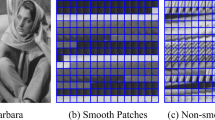Abstract
Inspired by the outstanding performance of sparse coding in applications of image denoising, restoration, classification, etc., we propose an adaptive sparse coding method for painting style analysis that is traditionally carried out by art connoisseurs and experts. Significantly improved over previous sparse coding methods, which heavily rely on the comparison of query paintings, our method is able to determine the authenticity of a single query painting based on estimated decision boundary. Firstly, discriminative patches containing the most representative characteristics of the given authentic samples are extracted via exploiting the statistical information of their representation on the DCT basis. Subsequently, the strategy of adaptive sparsity constraint which assigns higher sparsity weight to the patch with higher discriminative level is enforced to make the dictionary trained on such patches more exclusively adaptive to the authentic samples than via previous sparse coding algorithms. Relying on the learnt dictionary, the query painting can be authenticated if both better denoising performance and higher sparse representation are obtained, otherwise it should be denied. Extensive experiments on impressionist style paintings demonstrate efficiency and effectiveness of our method.
Zhi Gao and Mo Shan—denotes joint first author.
Access this chapter
Tax calculation will be finalised at checkout
Purchases are for personal use only
Similar content being viewed by others
Notes
- 1.
Due on one hand to the copyright issue, the high quality reproductions of the paintings in the museums are rarely publicly available even for research purpose, on the other hand to the fact that museums usually have no interests to acquire and keep paintings that are known as forgeries.
References
Abry, P., Wendt, H., Jaffard, S.: When Van Gogh meets Mandelbrot: multifractal classification of painting’s texture. Sig. Process. 93, 554–572 (2013)
Berezhnoy, I.E., Postma, E.O., van den Herik, H.J.: Automatic extraction of brushstroke orientation from paintings. Mach. Vis. Appl. 20, 1–9 (2009)
Bissantz, N., Dmbgen, L., Munk, A., Stratmann, B.: Convergence analysis of generalized iteratively reweighted least squares algorithms on convex function spaces. SIAM J. Optim. 19, 1828–1845 (2009)
Blessing, A., Wen, K.: Using machine learning for identification of art paintings. Technical report, Stanford University, Stanford (2010)
Castrodad, A., Sapiro, G.: Sparse modeling of human actions from motion imagery. IJCV 100, 1–15 (2012)
Cong, Z., Xiaogang, W., Wai-Kuen, C.: Background subtraction via robust dictionary learning. EURASIP J. Image Video Process. 2011 (2011)
Elad, M.: Sparse and Redundant Representations: From Theory to Applications in Signal and Image Processing. Springer, New York (2010)
Elad, M., Aharon, M.: Image denoising via sparse and redundant representations over learned dictionaries. IEEE Trans. Image Process. 15, 3736–3745 (2006)
Hughes, J.M., Graham, D.J., Rockmore, D.N.: Quantification of artistic style through sparse coding analysis in the drawings of pieter bruegel the elder. In: Proceedings of the National Academy of Sciences, vol. 107, pp. 1279–1283 (2010)
Jacobsen, R.: Digital painting analysis: authentication and artistic style from digital reproductions. Ph.D. thesis, Aalborg University, Aalborg (2012)
Johnson, C.R., Hendriks, E., Berezhnoy, I.J., Brevdo, E., Hughes, S.M., Daubechies, I., Li, J., Postma, E., Wang, J.Z.: Image processing for artist identification. IEEE Sig. Process. Mag. 25, 37–48 (2008)
Koh, K., Kim, S.J., Boyd, S.P.: An interior-point method for large-scale l1-regularized logistic regression. J. Mach. Learn. Res. 8, 1519–1555 (2007)
Li, J., Wang, J.Z.: Studying digital imagery of ancient paintings by mixtures of stochastic models. IEEE Trans. Image Process. 13, 340–353 (2004)
Li, J., Yao, L., Hendriks, E., Wang, J.Z.: Rhythmic brushstrokes distinguish van gogh from his contemporaries: findings via automated brushstroke extraction. IEEE Trans. PAMI 34, 1159–1176 (2012)
Liu, Y., Pu, Y., Xu, D.: Computer analysis for visual art style. SIGGRAPH Asia 2013 Technical Briefs, p. 9. ACM (2013)
Mairal, J., Bach, F., Ponce, J.: Task-driven dictionary learning. IEEE Trans. PAMI 34, 791–804 (2012)
Melzer, T., Kammerer, P., Zolda, E.: Stroke detection of brush strokes in portrait miniatures using a semi-parametric and a model based approach. In: International Conference on Pattern Recognition, vol. 1, pp. 474–476 (1998)
Olshausen, B.A., Field, D.J.: Emergence of simple-cell receptive field properties by learning a sparse code for natural images. Nature 381, 607–609 (1996)
Stork, D.G.: Computer vision and computer graphics analysis of paintings and drawings: an introduction to the literature. In: Jiang, X., Petkov, N. (eds.) CAIP 2009. LNCS, vol. 5702, pp. 9–24. Springer, Heidelberg (2009)
Stork, D.G., Coddington, J.: Computer image analysis in the study of art. In: Proceeding of SPIE, vol. 6810 (2008)
Stork, D.G., Coddington, J., Bentkowska-Kafel, A.: Computer vision and image analysis of art II. In: Proceeding of SPIE, vol. 7869 (2011)
Taylor, R.P., Micolich, A.P., Jonas, D.: Fractal analysis of pollock’s drip paintings. Nature 399, 422–422 (1999)
van den Herik, H.J., Postma, E.O.: Discovering the visual signature of painters. In: Kasabov, N. (ed.) Future Directions for Intelligent Systems and Information Sciences. STUDFUZZ, vol. 45, pp. 129–147. Springer, Heidelberg (2000)
Wagner, A., Wright, J., Ganesh, A., Zhou, Z., Mobahi, H., Ma, Y.: Toward a practical face recognition system: robust alignment and illumination by sparse representation. IEEE Trans. PAMI 34, 372–386 (2012)
Yelizaveta, M., Tat-Seng, C., Ramesh, J.: Semi-supervised annotation of brushwork in paintings domain using serial combinations of multiple experts. In: Proceedings of the 14th Annual ACM International Conference on Multimedia, pp. 529–538. ACM (2006)
Acknowledgement
This work is supported by these Grants: theory and methods of digital conservation for cultural heritage (2012CB725300), PSF Grant 1321202075, and the Singapore NRF under its IRC@SG Funding Initiative and administered by the IDMPO at the SeSaMe centre.
Author information
Authors and Affiliations
Corresponding author
Editor information
Editors and Affiliations
Rights and permissions
Copyright information
© 2015 Springer International Publishing Switzerland
About this paper
Cite this paper
Gao, Z., Shan, M., Cheong, LF., Li, Q. (2015). Adaptive Sparse Coding for Painting Style Analysis. In: Cremers, D., Reid, I., Saito, H., Yang, MH. (eds) Computer Vision -- ACCV 2014. ACCV 2014. Lecture Notes in Computer Science(), vol 9004. Springer, Cham. https://doi.org/10.1007/978-3-319-16808-1_8
Download citation
DOI: https://doi.org/10.1007/978-3-319-16808-1_8
Published:
Publisher Name: Springer, Cham
Print ISBN: 978-3-319-16807-4
Online ISBN: 978-3-319-16808-1
eBook Packages: Computer ScienceComputer Science (R0)




